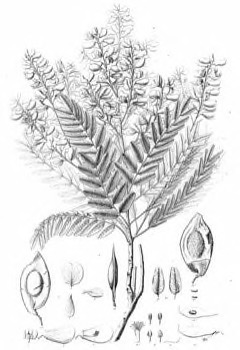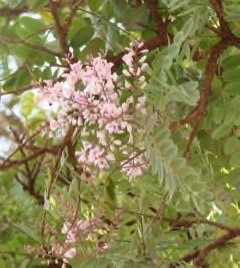 |
|
http://www.edibleplants.org |
 |
| João Medeiros wikimedia.org |
Translate this page:
Summary
Pterodon emarginatus is a slow-growing, deciduous tree characterized by an ellipsoidal crown and more or less straight bole reaching up to 60cm in diameter. It grows up to 16m tall and is commonly found in South America. Rheumatism can be treated using an essential oil from the bark of this plant. 'Batata de sucupira', a tuberous swelling on the roots, is used in the treatment of diabetes. Oil from fruits is used to prevent the occurrence of diseases. There are no known edible uses of this plant. Wood is highly durable and has excellent mechanical properties. It is used in naval and general construction, bridges, poles, railway sleepers, etc. It is also used for fuel and to make charcoal.
Physical Characteristics

 Pterodon emarginatus is a deciduous Tree growing to 12 m (39ft) by 12 m (39ft) at a medium rate.
Pterodon emarginatus is a deciduous Tree growing to 12 m (39ft) by 12 m (39ft) at a medium rate.
See above for USDA hardiness. It is hardy to UK zone 10. The flowers are pollinated by Insects.
Suitable for: light (sandy) and medium (loamy) soils and prefers well-drained soil. Suitable pH: mildly acid, neutral and basic (mildly alkaline) soils. It cannot grow in the shade. It prefers dry or moist soil and can tolerate drought.
UK Hardiness Map
US Hardiness Map
Synonyms
Acosmium inornatum (Mohlenbr.) Yakovlev Commilobium polygalaeflorus Benth. Commilobium pubescens Ben
Plant Habitats
Edible Uses
References More on Edible Uses
Medicinal Uses
Plants For A Future can not take any responsibility for any adverse effects from the use of plants. Always seek advice from a professional before using a plant medicinally.
Antirheumatic Parasiticide
An essential oil obtained from the bark is applied externally to affected areas in the treatment of rheumatism[739 ]. A tuberous swelling that is occasionally found on the roots, known as 'batata de sucupira', is used in the treatment of diabetes[739 ]. The oil from the fruits has been shown to inhibit the penetration of Schistosoma cercariae (the larval stage that causes schistosomiasis) into the skin of humans[739 ]. The oil can therefore be used as a prophylactic treatment to prevent the disease[739 ]. This property is due to the presence of 14,15-epoxigeranylgeraniol in the oil[739 ].
References More on Medicinal Uses
The Bookshop: Edible Plant Books
Our Latest books on Perennial Plants For Food Forests and Permaculture Gardens in paperback or digital formats.

Edible Tropical Plants
Food Forest Plants for Hotter Conditions: 250+ Plants For Tropical Food Forests & Permaculture Gardens.
More

Edible Temperate Plants
Plants for Your Food Forest: 500 Plants for Temperate Food Forests & Permaculture Gardens.
More

More Books
PFAF have eight books available in paperback and digital formats. Browse the shop for more information.
Shop Now
Other Uses
Charcoal Essential Fuel Parasiticide Wood
Agroforestry Uses: Although slow-growing, this species makes a good component in planting schemes for restoring native woodland, especially in the drier areas of the cerrado and adjoining semideciduous forest[419 ]. Other Uses The wood is compact, cross-grained, heavy, very hard, difficult to split, with excellent mechanical properties and very durable, even when in contact with the soil. It is used in naval construction, general construction, bridge stanchions, poles, railway sleepers, cart bodies etc[419 ]. The wood is used for fuel and to make charcoal[419 ].
Special Uses
References More on Other Uses
Cultivation details
Requires a sunny position[419 ]. Prefers the drier, sandy soils in the wild, but in cultivation can tolerate a wider range of conditions so long as the soil is well-drained[419 ]. Established plants are very drought tolerant[419 ]. A slow-growing tree when very young, though it does speed up somewhat after 2 - 3 years[419 , 420 ]. Although many species within the family Fabaceae have a symbiotic relationship with soil bacteria, this species is said to be devoid of such a relationship and therefore does not fix atmospheric nitrogen[755 ].
References Carbon Farming Information and Carbon Sequestration Information
Temperature Converter
Type a value in the Celsius field to convert the value to Fahrenheit:
Fahrenheit:
The PFAF Bookshop
Plants For A Future have a number of books available in paperback and digital form. Book titles include Edible Plants, Edible Perennials, Edible Trees,Edible Shrubs, Woodland Gardening, and Temperate Food Forest Plants. Our new book is Food Forest Plants For Hotter Conditions (Tropical and Sub-Tropical).
Shop Now
Plant Propagation
Seed - it has a hard seedcoat and may benefit from scarification before sowing to speed up germination. This can usually be done by pouring a small amount of nearly boiling water on the seeds (being careful not to cook them!) and then soaking them for 12 - 24 hours in warm water. By this time they should have imbibed moisture and swollen - if they have not, then carefully make a nick in the seedcoat (being careful not to damage the embryo) and soak for a further 12 hours before sowing. Seedlings are very sensitive to root disturbance, so the seed is best sown as soon as it is ripe in a partially shaded position in individual containers. A very low germination rate can be expected from untreated seed, with the seed sprouting within 30 - 50 days[419 ].
Other Names
If available other names are mentioned here
Faveiro - Portuguese (Brazil), sucupira - Portuguese (Brazil), sucupira-branca - Portuguese (Brazil). fava-de-santo-inácio, faveiro, sucupira, sucupira-branca.
Native Plant Search
Search over 900 plants ideal for food forests and permaculture gardens. Filter to search native plants to your area. The plants selected are the plants in our book 'Plants For Your Food Forest: 500 Plants for Temperate Food Forests and Permaculture Gardens, as well as plants chosen for our forthcoming related books for Tropical/Hot Wet Climates and Mediterranean/Hot Dry Climates. Native Plant Search
Found In
Countries where the plant has been found are listed here if the information is available
Brazil; Bolivia, Plurinational State of
Weed Potential
Right plant wrong place. We are currently updating this section.
Please note that a plant may be invasive in one area but may not in your area so it’s worth checking.
Conservation Status
IUCN Red List of Threatened Plants Status : This taxon has not yet been assessed

Growth: S = slow M = medium F = fast. Soil: L = light (sandy) M = medium H = heavy (clay). pH: A = acid N = neutral B = basic (alkaline). Shade: F = full shade S = semi-shade N = no shade. Moisture: D = dry M = Moist We = wet Wa = water.

Expert comment
Author
Vogel
Botanical References
Links / References
For a list of references used on this page please go here
A special thanks to Ken Fern for some of the information used on this page.
Readers comment
| Add a comment |
|
If you have important information about this plant that may help other users please add a comment or link below. Only comments or links that are felt to be directly relevant to a plant will be included. If you think a comment/link or information contained on this page is inaccurate or misleading we would welcome your feedback at [email protected]. If you have questions about a plant please use the Forum on this website as we do not have the resources to answer questions ourselves.
* Please note: the comments by website users are not necessarily those held by PFAF and may give misleading or inaccurate information.
To leave a comment please Register or login here All comments need to be approved so will not appear immediately.
|
Subject : Pterodon emarginatus
|
|
|
|